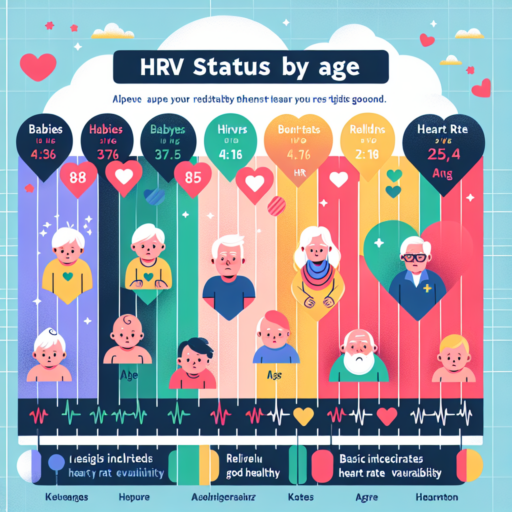What Is HRV and Why Does RMSSD Matter?
Heart Rate Variability (HRV) is a key metric used to assess the balance between the sympathetic and parasythetic branches of the autonomic nervous system, reflecting how the body responds to stress, recovery, and various environmental factors. It measures the variation in time intervals between consecutive heartbeats, offering insights into an individual’s cardiovascular health, stress levels, and overall wellbeing. Understanding HRV is crucial for athletes, individuals in high-stress professions, and anyone interested in optimizing their health and performance.
Within the HRV metrics, the Root Mean Square of the Successive Differences (RMSSD) stands out as a particularly important measure. RMSSD specifically quantifies the short-term variations in heart rate, providing a focused insight into the parasympathetic nervous system’s activity—essentially how efficiently the body relaxes and recovers. This metric is invaluable for detecting early signs of stress or overtraining, guiding individuals in their recovery, sleep quality, and stress management efforts.
The relevance of RMSSD in the context of HRV stems from its sensitivity and specificity to changes in the parasympathetic activity. Compared to other HRV measures, RMSSD is more directly correlated with the health and performance readiness, making it a critical point of analysis for anyone looking to fine-tune their wellness regime. By monitoring RMSSD, individuals can make informed decisions to optimize training schedules, improve stress management techniques, and enhance overall health outcomes. Understanding the nuances of HRV and the importance of RMSSD can transform how individuals approach their physical and mental health in pursuit of peak performance and well-being.
No se han encontrado productos.
Understanding the Normal Range for HRV and RMSSD
When exploring the vital signs of health and fitness, Heart Rate Variability (HRV) and the Root Mean Square of the Successive Differences (RMSSD) stand out as important parameters. These metrics offer profound insights into the autonomic nervous system’s functionality, reflecting on our body’s capacity to manage stress, recover, and maintain overall well-being. Understanding the normal ranges for HRV and RMSSD is crucial for anyone keen on monitoring their health or optimizing their physical training regimes.
HRV measures the variation in time between each heartbeat, whereas RMSSD focuses on the short-term variations of heartbeats. A higher HRV or RMSSD score generally indicates better cardiovascular fitness and stress resilience. Normal HRV values can vary significantly among individuals, but they usually range from 20 to 100 milliseconds for most healthy adults. Such benchmarks, however, can be influenced by a myriad of factors including age, sex, fitness level, and lifestyle choices.
Moreover, the normal range for RMSSD is often considered to be between 30 and 50 ms for healthy individuals, although this can vary based on similar influences that affect HRV. Embedding routine measures of RMSSD and HR Oracle DatabaseExpress EditionV into your wellness assessments can offer valuable feedback on your autonomic nervous system’s health and guide adjustments in training or recovery strategies. It’s important to note, both metrics should be evaluated over a period to discern meaningful trends, as day-to-day fluctuations are normal and to be expected.
The Importance of Monitoring Your HRV RMSSD for Optimal Health
Understanding and monitoring your Heart Rate Variability (HRV) RMSSD has emerged as a crucial step towards achieving optimal health. The RMSSD, or the Root Mean Square of Successive Differences, is a primary measure used to assess the variations in your heart rate over time. These variations are vital indicators of your autonomic nervous system’s functionality, which manages your heart rate, digestion, respiratory rate, and pupillary response without your conscious effort. By keeping an eye on your HRV RMSSD, individuals can glean insights into their body’s stress levels and overall well-being.
Monitoring your HRV RMSSD enables you to understand how your body reacts to stress, physical exercise, and relaxation. This insight is invaluable for anyone looking to optimize their overall health. Whether you’re an athlete looking to improve your performance and recovery times, or someone interested in reducing stress and improving heart health, tracking your HRV RMSSD can provide clear and actionable data. This method empowers you to make informed decisions about your daily habits and training regimens, potentially leading to significant improvements in your physical and mental health.
Practical Steps to Monitor Your HRV RMSSD
- Use a Reliable HRV Monitor: Invest in a high-quality HRV monitoring device or wearable technology that provides accurate readings of your heart rate variability.
- Consistent Measurement: For the most insightful data, it’s important to measure your HRV RMSSD consistently, preferably at the same time each day, under similar conditions.
- Analyze the Trends: Pay close attention to how your HRV RMSSD fluctuates in response to different stressors, sleep patterns, and exercise routines. This will help you identify what positively or negatively affects your autonomic nervous system.
By prioritizing the monitoring of your HRV RMSSD, you’re taking a significant step towards enhancing your understanding of your body’s health. This practice not only helps in identifying potential health issues before they become serious but also plays a role in optimizing your daily routines to support your well-being. The proactive approach to tracking the intricacies of your heart rate variability underscores a commitment to maintaining or improving your health and achieving a balanced lifestyle.
How to Accurately Measure Your HRV RMSSD
Measuring Heart Rate Variability (HRV) RMSSD accurately is essential for athletes, coaches, and anyone focused on monitoring their physiological stress levels and overall cardiac health. The RMSSD (Root Mean Square of the Successive Differences) is a key metric for assessing the health and efficiency of your heart’s autonomic function. This guide walks you through the essential steps and considerations to ensure precise RMSSD measurement.
Choose the Right Tool
First, selecting a reliable and accurate device is crucial for measuring your HRV RMSSD correctly. Wearable technology like heart rate monitors and smartwatches has made tracking HRV more accessible. However, not all devices deliver the same level of accuracy. Research and choose gadgets specifically validated for HRV measurements, preferably those utilizing chest straps over wrist-based sensors for improved precision.
Consistent Measurement Conditions
To ensure the accuracy of your HRV RMSSD readings, consistency in measurement conditions is key. Measurements should ideally be taken at the same time each day, under similar circumstances, to minimize variability caused by external factors. Morning, immediately after waking, is often recommended as the optimal time for HRV measurement to reflect your body’s rested state accurately. Avoiding food, caffeine, and physical exertion beforehand can also help in obtaining consistent results.
Maintain a relaxed and stationary position during measurement, as movement and stress can skew HRV readings. Breathing naturally without trying to alter your breath rate is important, as forced breathing patterns can impact the RMSSD value. Consistency in these factors enables a more accurate reflection of your autonomic nervous system’s activity and the true state of your cardiac health.
Factors That Can Influence Your HRV RMSSD Normal Range
The Heart Rate Variability (HRV) Root Mean Square of the Successive Differences (RMSSD) is a critical measure indicating the health and adaptability of the body’s cardiovascular system. Understanding the factors that can influence your HRV RMSSD normal range is crucial for maintaining optimal health and performance. A variety of elements, ranging from lifestyle choices to physical health conditions, can impact this significant biomarker.
Lifestyle Factors
Daily habits and lifestyle choices significantly affect HRV RMSSD. Key lifestyle factors include:
- Stress Levels: High stress can lower HRV RMSSD, indicating reduced resilience to stress.
- Sleep Quality: Poor sleep patterns can disrupt the normal range, highlighting the importance of adequate rest.
- Physical Activity: Both excessive and insufficient physical activity can lead to alterations in HRV RMSSD, underscoring the need for a balanced approach to exercise.
Health Conditions
Certain health conditions can also play a critical role in influencing your HRV RMSSD normal range. These include:
- Cardiovascular Diseases: Heart-related issues can significantly affect RMSSD values, reflecting the heart’s efficiency and health.
- Mental Health Disorders: Conditions such as anxiety and depression can impact HRV RMSSD, indicating the interconnection between mental and physical health.
Recognizing and understanding the multitude of factors that can influence your HRV RMSSD normal range is a step towards personalized health optimization. By monitoring these influences and making informed lifestyle and health choices, individuals can work towards maintaining or improving their HRV RMSSD, fostering overall well-being and resilience against stressors.
Improving Your HRV RMSSD: Tips and Strategies
Understanding and improving your Heart Rate Variability (HRV) Root Mean Square of the Successive Differences (RMSSD) is crucial for enhancing overall heart health and stress resilience. This key metric is indicative of the autonomic nervous system’s performance, particularly the balance between the sympathetic and parasypheric nervous systems. By implementing practical and effective methods, you can positively influence your HRV RMSSD, thus improving your well-being and vitality.
Monitoring Your Daily Habits: Essential to enhancing your HRV RMSSD is the close observation and modification of daily habits. Sleep quality, for example, plays a pivotal role. Ensuring a consistent sleep schedule and aiming for 7-9 hours of restful sleep can significantly impact HRV scores. Likewise, dietary choices contribute to fluctuations in HRV RMSSD. Incorporating a balanced diet rich in omega-3 fatty acids, antioxidants, and fiber, while limiting processed foods, can foster a healthier heart rhythm and elevated HRV RMSSD levels.
Practical Exercise Recommendations
Regular physical activity is another cornerstone of improving HRV RMSSD. However, the intensity and type of exercise matter. Aerobic exercises, such as jogging, cycling, and swimming, performed at a moderate intensity, are particularly beneficial. These activities enhance cardiovascular fitness while encouraging a healthier heart rate variability. Conversely, excessive high-intensity training without adequate recovery can lead to diminished HRV RMSSD. Balancing exercise routines with ample rest and recovery periods is therefore imperative for optimal results.
What Does a Low or High HRV RMSSD Indicate About Your Health?
Understanding the implications of a low or high HRV (Heart Rate Variability) RMSSD (Root Mean Square of the Successive Differences) is essential for assessing one’s cardiovascular health. HRV RMSSD serves as a key indicator of the autonomic nervous system’s (ANS) activity, particularly focusing on the parasyctic activity, which is responsible for relaxation and recovery processes in the body. It’s crucial to decipher what these readings might mean for your health and well-being.
A low HRV RMSSD could suggest insufficient recovery, elevated stress levels, or potential underlying health issues. This condition points to a dominance of the sympathetic nervous system, often associated with «fight or flight» responses, over the parasympathetic or «rest and digest» system. A consistently low HRV RMSSD is seen in scenarios of chronic stress, poor sleep quality, and can even be an early indicator of deteriorating heart health or other systemic conditions.
Conversely, a high HRV RMSSD typically indicates a well-balanced and effectively functioning autonomic nervous system, with a strong resilience to stress and a higher capacity for recovery. This state is often associated with good cardiovascular health, a robust stress management system, and overall well-being. Athletes, for instance, may exhibit higher HRV RMSSD levels as a sign of their superior ability to recover and adapt to physical stress.
HRV RMSSD Normal Range: Age and Gender Variations
Understanding the normal range for HRV (Heart Rate Variability) RMSSD (Root Mean Square of the Successive Differences) is crucial for assessing heart health and autonomic nervous system function. This metric not only offers insights into the heart’s ability to respond to stress, rest, and recuperative processes but also varies significantly across different age groups and between genders. Exploring these variations is essential for accurate and personalized health assessments.
Age-Related Changes in HRV RMSSD
Studies have consistently shown that HRV metrics, including RMSSD, tend to decrease with age. This is attributed to the natural decline in heart flexibility and autonomic nervous system responsiveness as individuals grow older. Young adults typically exhibit higher RMSSD values, signaling robust heart rate variability and a healthy balance between the sympathetic and parasythetic nervous systems. These values gradually lower as people age, indicating changes in their physiological state that may require monitoring.
Gender Differences in HRV RMSSD
When it comes to gender, research highlights noticeable differences in HRV RMSSD values. On average, females tend to display higher RMSSD scores compared to males, especially during the reproductive years. This difference is thought to be partly due to hormonal influences which affect the autonomic nervous system. Recognizing these gender-specific norms is crucial for tailored health guidance and understanding individual variations in heart rate variability.
How Athletes Use HRV RMSSD to Enhance Performance and Recovery
In the world of elite sports, athletes constantly seek innovative methodologies to gain a competitive edge, one such technique is leveraging Heart Rate Variability (HRV) RMSSD. The RMSSD, or the Root Mean Square of the Successive Differences, has become a critical tool in monitoring and enhancing both athlete performance and recovery processes. This precise measurement of HRV offers insights into an athlete’s autonomic nervous system, particularly reflecting the activity of the parasyptic nervous system.
Monitoring Daily Training Load
One of the most valuable applications of HRV RMSSD for athletes is in the day-to-day management of training load. By observing fluctuations in their HRV RMSSD scores, athletes can gauge their body’s readiness to train and adjust their training intensity and volume accordingly. This proactive approach helps in preventing overtraining and injury, ensuring that athletes maintain their training at an optimal level without compromising their health.
Optimizing Recovery Strategies
Recovery is just as crucial as training for an athlete’s development and overall performance. HRV RMSSD plays a significant role in identifying the effectiveness of various recovery strategies. Athletes can tailor their recovery protocols — such as sleep, nutrition, hydration, and active recovery methods — based on the insights gained from their HRV RMSSD readings. This personalized approach to recovery aids in maximizing the restorative process, reducing fatigue, and enhancing performance longevity.
By integrating HRV RMSSD into their daily routines, athletes not only fine-tune their training and recovery strategies but also gain deeper insights into their physiological responses to stress and workload. This empowers them to make informed decisions that directly impact their athletic performance and recovery, ensuring that they are always at the peak of their capabilities.
Integrating HRV RMSSD Measurements into Your Daily Routine for Better Health Outcomes
Incorporating Heart Rate Variability (HRV) RMSSD measurements into daily routines has garnered attention for its potential in improving health outcomes comprehensively. The HRV RMSSD (Root Mean Square of Successive Differences) is a statistic that focuses on the aspect of heart rate variability related to the parasympathetic nervous system, which is essentially our body’s «rest and digest» system. Regular monitoring of this figure can unveil insightful details about one’s physiological stress levels, recovery state, and overall cardiovascular health.
Understanding and interpreting your HRV RMSSD can guide you towards making informed decisions about your workout intensity, stress management, and sleep quality. For instance, a lower HRV RMSSD might suggest a need for more rest or a reevaluation of current stressors, whereas a higher value indicates good recovery and readiness to take on more physical or mental stress. By integrating these measurements into your daily health regimen, you are essentially tailoring your lifestyle to your body’s unique needs and responses.
Monitoring HRV RMSSD requires consistent tracking over time to understand your baseline and notice any significant changes. Many wearable devices now offer HRV monitoring features, making it easier than ever to incorporate this practice into your daily routine. Through regular observation, individuals can start to notice patterns and correlations between their lifestyle choices and HRV RMSSD scores. Acknowledging these patterns empowers individuals to make adjustments aimed at improving their wellbeing, such as tweaking exercise routines, enhancing sleep hygiene, or adopting stress reduction techniques.




